NEW! FENCES THAT WORK BOOKLET
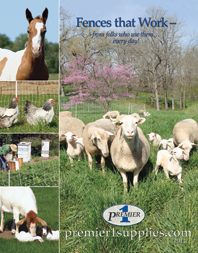 New!
New!
2014 Fence Booklet
Our new catalog includes, along with our standard products, the following new item:
HotShock® & IntelliShock® Energizers
(Expected mid-April 2014.)
Low-cost, new design! 0.5, 1, 2 and 3 joule units that use either battery or plug-in power.
IntelliShock DC units are variable draw—which means they use less energy when the fence is clean, thus increasing battery life and reducing cost.
PREMIER NETTING
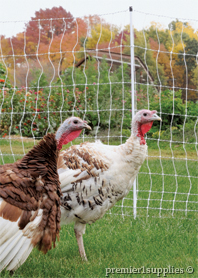
PoultryNet™ will contain and protect domestic turkeys as well as chickens, ducks and geese. Always keep netting electrified to prevent birds from damaging it (and themselves).
Premier is the source of 80% of the USA's electric netting. And we're the world leader for new netting designs and uses!
Why Premier “knows” netting…
| • |
We’ve used it for 44 years (since 1970)—longer than anyone in the US. |
| • |
It’s in use 24/7 at Premier to fence sheep, goats, poultry and dogs in—and to fence deer, coyotes and stray dogs out. |
| • |
We talk daily to netting users nationwide—who let us know what they like and/or dislike; when it works and when and why it doesn’t. |
| • |
View our Netting Comparison Chart to compare all of our nets. |
We have 3 netting videos available:
PREMIER ENERGIZERS
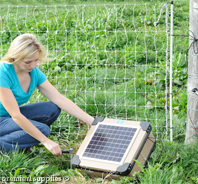
When using a PRS Solar Energizer during the summer months, face panels upward to take advantage of available sunlight.
PRS Solar Energizers
Which unit is right for you?
The size, in pulse energy output (range from .5 joule to 2 joules), depends almost entirely on the weed contact that will occur and the length of the fence.
Contact Premier or call 800-282-6631 to speak with one of our fence consultants for assistance in determining the best energizer for your needs. We have a unique 2-year rapid replacement warranty on all of our energizers.
For help in choosing an energizer, view our energizer comparison charts online or in Premier's fencing catalog.
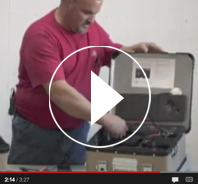
Fencing season is here. You'll find useful information in our video above on "How to get your PRS Solar Energizer ready for fencing season", with instructions and tips the folks at Premier have learned by experience.
|
 |
 |
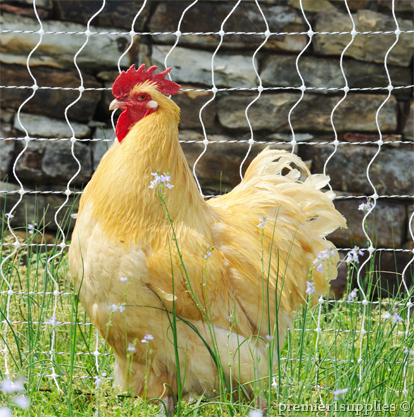
This Buff Orpington rooster is making sure the PoultryNet™ 12/42/3 fence is adequate to protect his hens. We're sure it passes muster.
Before you buy or build a fence
Q. What is the fence’s location? Is it flat? Or does it go over hills and ditches and around curves? Is it covered with brush, trees or open grass? Are the soils rocky, very soft, sandy or firm?
A. The optimum fence design often hinges on answers to these questions.
Q. Do the animals know the fence?
A. Local animals and wildlife get to “know” a fence by appearance, location and “pain memory.” If it’s a strong or painful fence they avoid it. On the other hand animals new to fences often challenge them. That’s why strong, tall, visible permanent fences are essential for corrals and feedlots. Temporary fences that are not physically strong pose the greatest risk of escape to newly acquired animals. It pays to train them to it inside of a permanent fence.
Q. What specific animals need to be fenced in or out?
A. Always design and build for the most difficult species. Rules of thumb:
| • |
Most poultry fences will stop sheep and goats. The inverse is not always true. |
| • |
If fencing hens with chicks (or only chicks), ducklings or goslings, a fence with smaller spacings (such as NoShock Chick Fence) should be used to prevent the small birds from slipping through the fence. |
| • |
Breeds that like to fly up and over need taller fences (e.g. flighty Leghorns, some bantams). |
Q. Should you energize the fence?
A. Yes! Why?
| • |
Animals are more surely contained or excluded. Predators are deterred by electrified fences. |
| • |
Energized fences last longer and require less maintenance—because animals do not crowd, rub, scratch or chew on them. So the fence wires (including wires that are not energized) require less tension to do their job. And braces and corner posts will last longer. |
Q. How keen will animals be to breach the fence line?
A. Build for the worst-case situation (if you can afford to do so). Some situations that require more secure fences:
| • |
Hunger. Starved animals will eventually challenge most fences |
| • |
Weaning. Strong physical barriers are needed. |
| • |
Breeding. Libido induces all creatures to challenge rules and especially fences. |
| • |
Boredom. Animals in corrals, stalls and feedlots crave any “entertainment” or activity. |
| • |
Gateways and handling yards. Animals often push each other into fences when being moved. |
| • |
Fear and fright. Predators or loud noises can cause “prey” species (e.g. horses, sheep, goats, turkeys, chickens, waterfowl) to run in terror straight into, under, over or through any fence, no matter what fence design (netting, high-tensile or woven wire). |
TEMPORARY AND SEMI-PERMANENT FENCE OPTIONS
Non-Electrifiable
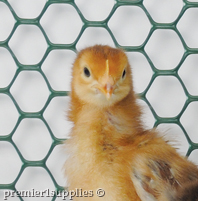
Allows young poultry to forage outside during the day when they're too small for standard netting, or to enclose older birds when predators are not a problem.
|
Why a NoShock Chick Fence?
Because chicks and ducklings are too small to be contained by PoultryNet™.
They can slip through the 2" x 3" openings at the bottom of PoultryNet. And they weigh too little to make an electrical connection to deter them.
That’s why we now offer a nonelectrifiable alternative to PoultryNet with “chick-stop” openings to keep in chicks, ducklings and other small birds.
Can also be used to keep free-range birds out of flowerbeds, gardens, patios, roadways.
Temporary...moved daily or weekly
Semi-Permanent...moved once per season
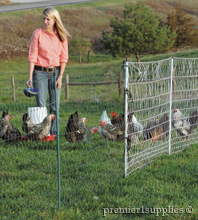
PoultryNet™ Plus in green blends into the grassy background. One white horizontal is built-in to make the net more visible at night. The PoultryNet™ Plus in black & white offers maximum visibility.
|
What is poultry netting?
An electrifiable, prefabricated, portable fence. Arrives as a complete (except for an energizer and corner posts) fence. A standard roll (164 ft) inclusive of posts weighs only 23 lbs.
White vertical plastic strings are “welded” to black and white electrifiable horizontal strings. They are supported by .60" diameter white plastic PVC posts—which are spaced throughout the netting. Each post has a small, steel spike that’s inserted into the soil for support.
How does netting work?
The horizontals (except for bottom one that rests on the grass) are energized by a fence energizer (purchased separately). When the birds (and predators on the outside) touch an electrified horizontal, they receive a shock from the very brief pulse—and learn to avoid it.
The close spacing of the verticals and horizontals (2"x3" at bird height) creates a physical and visual barrier for adult birds and their predators. Strings are used for verticals in order to reduce overall weight.
Why is it so popular?
| • |
Arrives via FedEx/UPS/SpeeDee at your door as a complete, preassembled fence. Line posts are prefitted into each roll. |
| • |
Keeps in adult poultry. |
| • |
Keeps out 4-footed predators (when properly energized). |
| • |
Much easier and faster than other fences to install, adjust, relocate and remove. Takes less than 10 minutes to install a roll. |
| • |
Flexible. Unlike permanent fences, netting is easy to install around corners and curves, into valleys and over hills. |
| • |
No tools needed. Only hand-tensioning. |
| • |
Endures. A roll will last 10 seasons if used with care. Its chief “enemies” are lawnmowers and ice/heavy snowfalls. |
How proven is it?
Energized poultry netting has been widely used in the US and Europe for 25 years. Producers now rely upon it.
How reliable is it?
Very reliable for adult birds that don’t fly (or have clipped wings)—if it’s properly electrified(at least 3000 volts). Not suited for chicks, ducklings and other young/small birds.
|
|